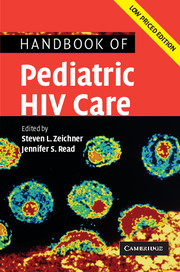Book contents
- Frontmatter
- Contents
- List of contributors
- List of abbreviations
- Foreword
- Preface
- Part I Scientific basis of pediatric HIV care
- Part II General issues in the care of pediatric HIV patients
- Part III Antiretroviral therapy
- 11 Antiretroviral therapy
- 12 Antiretroviral drug interactions
- 13 Metabolic complications of antiretroviral therapy in children
- 14 HIV drug resistance
- 15 Initiating and changing antiretroviral therapy
- 16 Therapeutic drug monitoring
- 17 HIV postexposure prophylaxis for pediatric patients
- Part IV Clinical manifestations of HIV infection in children
- Part V Infectious problems in pediatric HIV disease
- Part VI Medical, social, and legal issues
- Appendix 1 Formulary of antiretroviral agents
- Appendix 2 National Institutes of Health sponsored clinical trials for pediatric HIV disease
- Appendix 3 Selected HIV-related internet resources
- Appendix 4 Selected legal resources for HIV-infected children
- Index
- References
17 - HIV postexposure prophylaxis for pediatric patients
Published online by Cambridge University Press: 23 December 2009
- Frontmatter
- Contents
- List of contributors
- List of abbreviations
- Foreword
- Preface
- Part I Scientific basis of pediatric HIV care
- Part II General issues in the care of pediatric HIV patients
- Part III Antiretroviral therapy
- 11 Antiretroviral therapy
- 12 Antiretroviral drug interactions
- 13 Metabolic complications of antiretroviral therapy in children
- 14 HIV drug resistance
- 15 Initiating and changing antiretroviral therapy
- 16 Therapeutic drug monitoring
- 17 HIV postexposure prophylaxis for pediatric patients
- Part IV Clinical manifestations of HIV infection in children
- Part V Infectious problems in pediatric HIV disease
- Part VI Medical, social, and legal issues
- Appendix 1 Formulary of antiretroviral agents
- Appendix 2 National Institutes of Health sponsored clinical trials for pediatric HIV disease
- Appendix 3 Selected HIV-related internet resources
- Appendix 4 Selected legal resources for HIV-infected children
- Index
- References
Summary
Introduction
This chapter addresses HIV postexposure prophylaxis (PEP) in the following situations: injury from discarded needles, bite wounds, sexual exposure, and inadvertent exposure to human milk from an HIV-infected woman. In each setting, the risk of HIV transmission is directly related to the probability that the exposure source has HIV infection and that transmission of a sufficient amount of infectious virus occurred in a manner that could result in infection in the recipient. Because no studies have directly measured the effectiveness of PEP in decreasing the risk of HIV transmission in non-occupational settings or after mucosal exposure, the potential benefit of PEP in modifying transmission risk is extrapolated from data regarding HIV pathogenesis in animals, from information about PEP for needle-stick injuries in occupational settings, and from studies of mother-to-child transmission (MTCT) of HIV. Guidelines for prophylaxis after exposure to HIV in occupational and non-occupational settings have been published by the US Public Health Service (USPHS) [1–3], the American Academy of Pediatrics [4], the NY State Department of Health [5], and others [6].
Factors affecting HIV transmission risk after potential exposure
Type of source material
Not all body fluids from persons with HIV infection are equally infectious (Table 17.1). Blood and fluids contaminated with blood from persons with HIV infection are assumed to contain HIV and are associated with the highest risk of HIV transmission.
- Type
- Chapter
- Information
- Handbook of Pediatric HIV Care , pp. 450 - 470Publisher: Cambridge University PressPrint publication year: 2006



